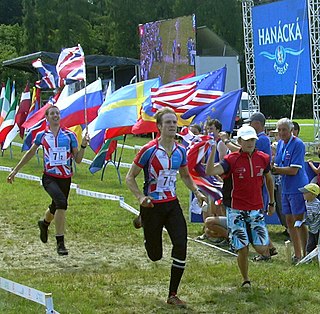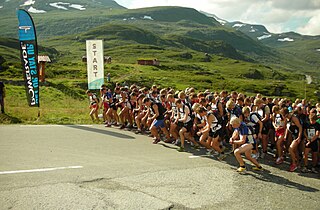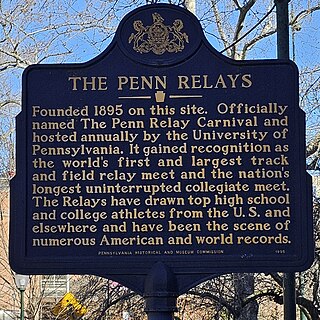
Hurdling is the act of jumping over an obstacle at a high speed or in a sprint. In the early 19th century, hurdlers ran at and jumped over each hurdle, landing on both feet and checking their forward motion. Today, the dominant step patterns are the 3-step for high hurdles, 7-step for low hurdles, and 15-step for intermediate hurdles. Hurdling is a highly specialized form of obstacle racing, and is part of the sport of athletics. In hurdling events, barriers known as hurdles are set at precisely measured heights and distances. Each athlete must pass over the hurdles; passing under or intentionally knocking over hurdles will result in disqualification.

A relay race is a racing competition where members of a team take turns completing parts of racecourse or performing a certain action. Relay races take the form of professional races and amateur games. Relay races are common in running, orienteering, swimming, cross-country skiing, biathlon, or ice skating. In the Olympic Games, there are several types of relay races that are part of track and field. Relay race, also called Relay, is a track-and-field sport consisting of a set number of stages (legs), usually four, each leg run by different members of a team. The runner finishing one leg is usually required to pass the next runner a stick-like object known as a "baton" while both are running in a marked exchange zone. In most relays, team members cover equal distances: Olympic events for both men and women are the 400-metre and 1,600-metre relays. Some non-Olympic relays are held at distances of 800 m, 3,200 m, and 6,000 m. In the less frequently run medley relays, however, the athletes cover different distances in a prescribed order—as in a sprint medley of 200, 200, 400, 800 metres or a distance medley of 1,200, 400, 800, 1,600 metres.

Road running is the sport of running on a measured course over an established road. This differs from track and field on a regular track and cross country running over natural terrain.

Duathlon is an athletic event that consists of a running leg, followed by a cycling leg and then another running leg in a format similar to triathlons. The International Triathlon Union governs the sport internationally.

An ultramarathon, also called ultra distance or ultra running, is a footrace longer than the traditional marathon length of 42.195 kilometres. Various distances, surfaces, and formats are raced competitively, from the shortest common ultramarathon of 31 miles (50 km) and up to 3100 miles. World Championships are held by the International Association of Ultrarunners (IAU) for 50 km, 100 km, 24 hours, and ultra trail running. The Global Organization of Multi-Day Ultramarathoners (GOMU) holds World Championships for 48 hours and 6 days. World Records are ratified and recognized by World Athletics, the IAU, and by GOMU.

Trail running is a type of running that takes place on outdoor trails, often in mountainous terrain, and often includes significant ascents and descents. Trail running is overseen by the International Trail Running Association (ITRA) and includes longer races.

Fell running, also sometimes known as hill running, is the sport of running and racing, off-road, over upland country where the gradient climbed is a significant component of the difficulty. The name arises from the origins of the English sport on the fells of northern Britain, especially those in the Lake District. It has elements of trail running, cross country and mountain running, but is also distinct from those disciplines.

Ekiden (駅伝) is a long-distance running multi-stage relay race, mostly held on roads.

Dean Karnazes, is an American ultramarathon runner, and author of Ultramarathon Man: Confessions of an All-Night Runner, which details ultra endurance running for the general public.

The Ultra-Trail du Mont-Blanc (UTMB) is a mountain ultramarathon race, first held in 2003, that follows the route of the Tour du Mont Blanc. It has been regarded as the most competitive trail ultramarathon in the world.
Multiday races are ultramarathon running events which are typically either segmented into daily events of a specified distance or time, or staged so that runners can run as far as they want, at their own discretion, over a set course or over a set number of days. Multiday races can range from continuous 48-hour track events to staged transcontinental treks.

The Penn Relays is the oldest and largest track and field competition in the United States, hosted annually since April 21, 1895 by the University of Pennsylvania at Franklin Field in Philadelphia. In 2012, there were 116 events run at the meet. More athletes run in the Penn Relays than at any other track and field meet in the world. It regularly attracts more than 15,000 participants from high schools, colleges, and track clubs throughout North America and abroad, notably Jamaica, competing in more than 300 events over five days. Historically, the event has been credited with popularizing the running of relay races. It is held during the last full week in April, ending on the last Saturday in April. Attendance typically tops 100,000 over the final three days, and has been known to surpass 50,000 on Saturday. The Penn Relays also holds a Catholic Youth Organization night for Catholic Middle Schools in the Archdiocese of Philadelphia. Preliminaries are run on the Tuesday during Carnival Week, and the Finals are run on Friday.

Hood To Coast is a long distance relay race that starts at Mount Hood and continues nearly 200 miles to the Oregon Coast. Known as "the mother of all relays", it is the largest running and walking relay in the world, with 12,600 runners in the Hood To Coast relay and 19,000 total participants, including events like the Portland To Coast Walk. Founded in 1982, Hood To Coast is extremely popular and has filled its team limit for the past 36 years, most of the time on opening day of the entrance lottery.

The Leadville Trail 100 Run is an ultramarathon held annually on rugged trails and dirt roads near Leadville, Colorado, through the heart of the Rocky Mountains. First run in 1983, the race course climbs and descends 15,600 feet (4,800 m), with elevations ranging from 9,200 to 12,620 feet. In most years, fewer than half the starters complete the race within the 30-hour time limit.
The Reach the Beach Relay is a long distance relay race that is run through the picturesque hills and valleys of New Hampshire at the start of foliage season. It starts from Bretton Woods and ends at Hampton Beach.

The Cabot Trail Relay Race is an annual 276.33 km (171.70 mi) relay race around Cape Breton's Cabot Trail. The race takes place over 24 hours in 17 stages and features up to 70 teams and 1,200 runners. The race begins and ends in Baddeck, Nova Scotia. The annual event began in 1988, when just 6 teams participated. Since its founding, over 27,000 runners have participated in the event.

Legs for Literacy is an annual marathon held in Moncton, New Brunswick, Canada in October. The race day also includes a half marathon, 10 km, and 5 km race.

The Barcelona Trail Races or BTR is a running event that includes several mountain races or trail running races. It takes place once a year in the Collserola Park in Barcelona, Catalonia, Spain. The first edition was in 2013.
The backyard ultra or last one standing is a form of ultramarathon race where competitors must consecutively run the distance of 6.706 kilometres (4.167 mi) in less than one hour, which is a pace of 100 miles per 24 hours. The race is over when only one runner remains to complete a lap. This runner is marked as the winner and only finisher, with all other runners receiving a "DNF". The runner who completes the second-most laps in a race is often referred to as the "assist", in the sense that their effort is ultimately what determines how long the race is allowed to continue--there is no predefined end length or time in a backyard ultra, as long as multiple runners can complete each loop within an hour.

Gary Cantrell, known as Lazarus Lake, is an endurance race designer and director. His races include the Barkley Marathons, Big's Backyard Ultra, the Barkley Fall Classic, Vol State 500K, A Race for the Ages, the Last Annual Heart of the South, and the Strolling Jim 40. In 2018, Lake covered the United States on foot, starting in Rhode Island and ending in Oregon.


















